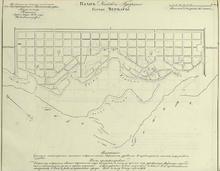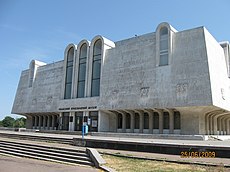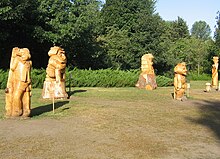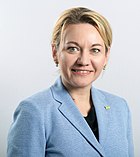|
Cherkasy
Cherkasy (Ukrainian: Черкаси, pronounced [tʃerˈkɑsɪ] ⓘ) is a city in central Ukraine. Cherkasy serves as the administrative centre of Cherkasy Oblast as well as Cherkasy Raion within the oblast. The city has a population of 269,836 (2022 estimate).[2] Cherkasy is the cultural, educational and industrial centre of Cherkasy Oblast and Central Economical Region of Ukraine. Cherkasy has been known since the 13th century and played a great role in the history of Ukraine. The city was the centre of the land of the Cossacks; its citizens took part in Khmelnychchyna and Koliivshchyna Cossack and peasant rebellions. The city is located on the right bank of Dnieper River (specifically at the Kremenchuk Reservoir), about 200 km (124 mi) south of the nation's capital, Kyiv. Cherkasy is divided into 2 urban districts: Sosnivskyi (with Orshanets village) and Prydniprovskyi. It hosts the administration of Cherkasy urban hromada, one of the hromadas of Ukraine.[3] In June 2011, the city celebrated its 725th anniversary. GeographyLocationCherkasy is situated on the high right bank of the Dnipro River, in the middle of the Kremenchuk Reservoir. Relief of the historical part of the city was influenced by Zamkova (Castle) mountain, where Cherkasy Castle was situated.[4][5] The major part of Cherkasy occurs as lowlands. The city occupies an area of 69 km2 (26.6 sq mi). The city's length is 17 km (10.56 mi) along the Kremenchuk Reservoir, while its widest point is only 8 km (4.97 mi). From the north-west, Cherkasy is surrounded by forest. Known as Cherkasy Forest, it is the biggest (28,500 hectares or 70,400 acres) natural pine forest in Ukraine.[6] Climate The climate of Cherkasy is mild continental, with mild winters and warm summers.[7] The average temperature in the city is +7.7 °C (45.9 °F). Winters are usually cold and snowy (the average January temperature is −5.9 °C (21.4 °F)). Summers are dry and warm (the average temperature in July is +19.8 °C (67.6 °F)), with occasional highs reaching +35 °C (95 °F).
EcologyThe ecological situation in the city is quite stable. The cumulative pollution index as of 2008[update] is 7.56, average with other Ukrainian cities. The main pollutant in the city is "Azot" plant, so the nearby area (south-east part of the city) is the most polluted.[11] The downtown area is heavily polluted as well, due to high traffic volume. The city itself is mostly clean of nuclear pollution from the Chernobyl disaster, although the northernmost part of Cherkasy may have been influenced a little.[12] Demographics
According to the newest data, the number of inhabitants of Cherkasy is 284,479 as of 1 October 2015.[14] This number is decreasing because of rising mortality rate, socio-economic situation, and the suburbanisation process in the region. According to the 2001 census, Ukrainians made up 83.31% of the population, Russians 13.14% and Jews 0.55%.[15] 46.4% are males, 53.6% are females.[16] According to the data provided by the municipal health care department, teens under 14 encompass 15% of the population while pensioners are 19%, which indicates the prevalence of aging citizens as compared to younger citizens. LanguageDistribution of the population by native language according to the 2001 census:[17]
According to a survey conducted by the International Republican Institute in April-May 2023, 80 % of the city's population spoke Ukrainian at home, and 18 % spoke Russian.[18] HistoryEarly historyThe history of Cherkasy has not been thoroughly explored. The year of establishment is considered by historians to be 1286 on the Kievan Rus' territory. There are few facts about the beginning of the city, but it is documented that Cherkasy existed in the 14th century. The first record about Cherkasy dates from 1305 in the Gustynskiy Chronicle, which is the Kievan Rus' chronicle. The city is mentioned as an existing city among other Kievan Rus' cities, including Kiev, Kaniv, Zhytomyr and Ovruch. The city became one of the centres of the Cossack movement. Citizens took part in the Khmelnychchyna of 1648-1657 and in the Koliivschyna of 1768–1769. The city was influenced by the cruel social and economical experiments of Soviet authorities and by World War II. In 1954 Cherkasy became the administrative centre of Cherkasy Oblast (province), the youngest oblast of Ukraine. Under the Grand Duchy of Lithuania  In the 1360s the city entered a new period in its development, becoming a part of the Grand Duchy of Lithuania. Cherkasy became an important defender of the southern borders of the Grand Duchy. In 1384 the city was recognized as a fortified town on the southern edge (of the Grand Duchy of Lithuania), forming along with Vinnytsia, Bratslav and Kaniv part of a defensive line against Crimean Tatars. The city started to be ruled by a headman (starosta). From the end of the 15th until the beginning of the 16th centuries, the post of Cherkasy headman was held by the prominent persons of that time – Bogdan Glinskiy (in office: 1488–1495), Kmyta Oleksandrovych (in office: 1494–1500), Vasyl Dashkevych (Ukrainian: Василь Дашкович Глинський, in office: 1504–1507), Andriy Nemyrovych (in office: 1511–1514), Ostafiy Dashkevych (in office: 1514–1535), Vasyl Tyshkevych, Dmytro Baida-Vyshnevetskiy (in office: 1550–1553) etc. During the 15th and 16th centuries Cherkasy was one of the main centres that helped the Cossacks in the peopling of the Ukrainian south. Citizens took part in military campaigns against Tatars and Turks, including operations led by Ivan Pidkova (died 1578). New Cherkasy Castle, built in 1549–52 on the place of the old one, was the centre of city life. Under Polish rule, Khmelnytsky Uprising After the Union of Lublin in 1569 Cherkasy became a part of Poland. Cherkasy Regiment, which was created in 1625, played a big role in history of the city. During the Khmelnytsky Uprising the regiment became administrative-territorial subdivision (until 1686). During that time Cherkasy's Regiment was one of the most powerful military units and took part in all of the battles for Bohdan Khmelnytsky army. After a successful campaign, Khmelnytsky in 1654 signed an alliance with Muscovy at Pereyaslav. The war ended in 1667 with the Truce of Andrusovo. Cherkasy remained part of Poland, but territories east of the Dnieper River including left-bank Ukraine and Zaporizhia were secured for Muscovy. While in the Polish Kingdom the city was a seat of the county (powiat) which belonged to a greater unit – the Kyiv Voivodeship of the Lesser Poland Province until 1793. In 1768 during the Koliyivshchyna turmoils the city was severely damaged and pillaged. In 1791 the city gained Magdeburg rights. It was a royal city of Poland. After the Second Partition of Poland the city was incorporated into the Kievan Guberniya of Imperial Russia. 19th – early 20th centuries Since the beginning of the 19th century the city was planned by Russian architect, civil engineer and town planner of Scottish descent, William Heste. After the second division of Poland in 1793, Cherkasy became part of the Russian Empire. From 1797 it was a povitove town of Kyiv Governorate. In the second half of the 19th century the city experienced a great economical growth. After the railroad appeared in the city, a lot of new industrial enterprises were built. Sugar, tobacco, metalwork, mechanical engineering and trade industries were at peak development at that time. Architect William Heste made a general development plan for the city, which involved building square blocks with straight streets. Ukrainian War of Independence, Second World War and Soviet period After the October Revolution in 1917 Cherkasy fell under Bolshevik control. After that, however, the city changed its ruler at least 18 times – during the civil war it was conquered by hetman Pavlo Skoropadskyi, then again by Bolsheviks, later by Nykyfor Hryhoriv. On 1 January 1920, the city finally and for a long period fell under Soviet rule. As with all villages and towns in the area, it was a victim of man-made famine in 1932–1933 (Holodomor) and a Great Purge (a series of campaigns of political repression and persecution in the Soviet Union organised by Joseph Stalin in 1936–1938).  The Second World War damaged the city greatly. On 22 June 1941, German bombers attacked Cherkasy. For two months soldiers defended the city, but on 22 August, the invaders took the city. On 14 December 1943, Cherkasy was liberated from the German invaders. After the end of the war, the city began to recover after being almost obliterated. According to 5-year plans, the city began to re-develop its economy, infrastructure and socio-cultural sphere. In 1954 the city became the administrative centre of Cherkasy Oblast (province), the youngest among other oblasts in Ukraine. In the 1960s Cherkasy became the chemical giant of the Ukrainian SSR, after "Azot" (the biggest nitrogen fertilizer producing plant), "Khimvolokno" (artificial fiber manufacturing plant), "Khimreaktyv" (chemical reagents for military purposes) and many others were built in the city. In 1961 a Kremenchuk hydro power plant was built, forming the Kremenchuk Water Reservoir, which Cherkasy is now standing on. This makes the city a big transport hub, serving the longest dyke in Ukraine (15 km) with rail and road on it. Independence from the Soviet UnionSince gaining independence, industry in the city has declined, along with the number of citizens and living standards. A lot of big and powerful factories and plants were privatized but couldn't survive in a competitive market. Some enterprises changed their profile – several (3) factories and plants around the city were united under the "Bogdan Corporation" and started production of buses and cars. Some of the companies remained working and became successful, like "Azot". On 28 November 2008, the monument of Lenin was removed from the central square. This caused different reactions in different people. Now the central square, formerly called "Lenin Square", is called "Soborna Square" (Cathedral Square). The square was recently renovated. In 2009, Cherkasy airport received International Airport status (IATA: CKC – ICAO: UKKE). Until 18 July 2020, Cherkasy was designated as a city of oblast significance and belonged to Cherkasy Municipality but not to Cherkasy Raion even though it was the centre of the raion. As part of the administrative reform of Ukraine, which reduced the number of raions of Cherkasy Oblast to four, the city was merged into Cherkasy Raion.[19][20] The city has occasionally seen Russian air strikes and missile attacks as a result of the Russian invasion of Ukraine, but has so far been untouched by ground-based warfare. Transportation Public transportationPublic transportation is represented by trolleybuses and buses. Trolleybuses started serving the city in 1965, and now are operating on 10 routes, from approximately 6 am till 11 pm. The fleet is old, and mostly consists of ZiU-9 and ZiU-10 vehicles. Recently, 3 new trolleybuses (manufactured by LAZ) appeared in the city. Buses are mostly represented with "Etalon", "Bohdan", and "PAZ" buses. Cherkasy City Bus is the authority that controls the buses in the city, it consists of several private contractors which actually operate the transport system.
Roads Cherkasy is a big transport hub due to its location in the centre of the country. Two major automobile routes go through the city – H16 (Uman-Zolotonosha, national route) and P10 (Kaniv-Kremenchuk, regional route). There is a 4-lane highway between Cherkasy and Smila (which is a part of Cherkasy Urban Agglomeration). The roads are in poor technical condition and road maintenance is poor. Railways The Cherkasy railway station is the main railway station that serves the city. The city also has a railway stop, and both are operated by the state-owned Ukrzaliznytsia company. Cherkasy has regular connections to neighbouring cities with small diesel trains. Major route Odesa-Moscow passes through Cherkasy. One of the most important railway junctions in Ukraine, is located 23 kilometres (14 miles) from Cherkasy, in the city of Smila, where the Kyiv–Dnipro and Odesa–Moscow rail routes cross. Air and Water transportAs Cherkasy is located on the bank of Kremenchuk reservoir, it has a small riverport. The previously extensive riverboat service along the Dnieper featuring the Raketa hydrofoil ships no longer exists, limiting river transport to cargo and tour boats and private pleasure craft. There is also a cargo port located in the city. Cherkasy International Airport is located on the western edge of the city. It handles chartered flights around Ukraine, because Boryspil airport in Kyiv handles most of Ukraine's International flights. In addition, Cherkasy airport is used as the alternative airport for Boryspil in case of unforeseen situations and adverse weather conditions. EconomyCherkasy is an important economic centre of Ukraine. The city is presented with different industries, but traditionally the greatest development was reached in chemical industry, automotive industry and food industry. Total yield, generated by Cherkasy industries was near ₴7,894.3 billion, or 64% of total income of Cherkasy Oblast. Main industry enterprises of Cherkasy: 
Education Nowadays there are different types of educational institutions in Cherkasy – pre-school (kindergartens), schools, out-of-school and higher educational institutions. These institutions may be both state-owned and private property. Pre-school education is represented with 50 kindergartens around the city. City-owned schools are 21 general schools, 1 night school, and 14 new-type schools – 2 lyceums, 3 gymnasiums, collegiate, 8 specialized schools. This include First City Gymnasium, City Gymnasium No. 9 and No. 31, Cherkasy Physical and Mathematical Lyceum, Cherkasy Lyceum of Humanities and Law, Specialized School No. 17 (Associated UNESCO school), Cherkasy Collegiate "Berehynia", Specialized Schools No. 3, #13, No. 18, #20, No. 27, #28 and No. 33. Private schools are "Perlyna", school No. 770, and "Sofia". Out-of-school institutions are Center of Youth Art, Young Sailors Club, Center of Tourism and Sports. There is a number of post-secondary educational institutions: 
There is a number of colleges (both state and private):
Several public libraries are serving the city – Central Library of Lesia Ukrainka, City Library for Youth and Children, Central Oblast Library of Taras Shevchenko. Culture and recreationCherkasy is a big cultural centre. Several theatres, philharmonic, 3 cinemas, numerous museums and clubs are serving the city. The city has 3 indoor skating rinks. People can relax in big parks and gardens around the city, they can also visit city's zoo. Cherkasy is among the cities in Ukraine that have their own planetarium. Museums The biggest museums of Cherkasy are:
Theatres and music There are several theatres in Cherkasy, such as:
The city has its own philharmonic, which was created in 1955. The big cultural centre is concert hall "Druzhba Narodiv" (Friendship of Nations), where all major concerts are held. Besides, there are numerous local cultural clubs. The city has 4 modern movie theatres – "Salut" (a very old building, was the first cinema in Cherkasy), "Ukraine", "Dnipro Plaza" and "Lubava".[21] Recreation Cherkasy is famous as a green city. The main parks are Park Peremohy (Victory Park) with a zoo, Sobornyi Park (Cathedral Park), Juvileyniy Park (Jubilee Park), Park Himikiv (Park of Chemists), Dolyna Troiand (Rose Valley), and two children's parks.[22] Traditional places of summer recreation are beaches of Dnipro River. The coastline of the city is as long as 15 kilometres (9 miles), and is usually represented with sand beaches. Infrastructure of the beaches is under development right now, although several recreational complexes are already built. On the northern end of the city, in Cherkasy Forest, sanatorium "Ukraine" is situated, along with three-star hotel "Ukraine", and "Kosmos-Bowling" club. There are also several hotels in the city which can accommodate people with different tastes. Festivals The city is famous for its sculpture festivals – "Kryzhtal" (held in winter, sculptures are made of ice), "Drevlyandia" (held in summer, sculptures are made of wood, then placed in parks around the city), and "Zhyvyi Kamin" (held in autumn, sculptures are made of stone). Along with the last, "Cherkasy's Singing Nights" are held in the open-air theatre in park. Since 2003, Cherkasy hosts international bike festival "Tarasova Gora", which gathers bikers from Ukraine, Russia, and other European countries. This is the biggest festival of this kind held in Ukraine. The city also hosts a music festival (sponsored by Pentax-Richo), that takes the name "Takumar5555", that is the old Pentax brand name, and a play on the city's 55th year of independence. Mass mediaCherkasy is a big media market, which is served by several local TV stations, newspapers, and numerous radio stations. The city is a home to numerous newspapers, among which are "Antenna", "Molod' Cherkashchyny", "Vechirni Cherkasy", "Akcent", "Nova Doba", "Misto", "Cherkasky Kray" etc. Cherkasy has 5 TV stations – Vikka, Antenna-Plus, Media-Center, Expo-TV, and state-owned Ros'. The city is also covered with nationwide channel broadcasting, like 1+1, Inter, ICTV, STB, TET etc. . City's radio stations are mostly nationwide networks broadcast on local frequencies, although some local stations exist. FM radio stations include KISS FM, Hit FM, Radio Luks, Radio Rocks, Shanson, Ros', Era FM, Love Radio, 101Dalmatin, Dobre Radio. Sports Sport life of the city is concentrated in several places, among which are the Central Stadium, Water Sport station, Sport Center "Spartak", "Ukraine"; Sport arena "Budivel'nyk"; "Astra", "Central", "Sokil" swimming pools; 2 ice rinks. Also, there are sport-entertainment centres, such as "Selena", "Bochka", and "Sportohota" which can usually be found on the bank of the Dnipro River. Every year more than 200 sport events, contests, competitions, tournaments are held in the city, with total of 10,000 participants. Some contests that were held recently include:
Other sport achievements are:
Architecture and sights  During its whole history Cherkasy was destroyed and rebuilt numerous times. Only few buildings from the 19th century survived. The system of streets and squares in the old part of the city is one of the few monuments to the city-building art of 19th century Ukraine.[25]
Notable people
 Sport
Twin towns – sister cities
See alsoReferences
External linksWikimedia Commons has media related to Cherkasy. Look up cherkasy in Wiktionary, the free dictionary.
Further reading
|
||||||||||||||||||||||||||||||||||||||||||||||||||||||||||||||||||||||||||||||||||||||||||||||||||||||||||||||||||||||||||||||||||||||||||||||||||||||||||||||||||||||||||||||||||||||||||||||||||||||||||||||||||||||||||||||||||||||||||||||||||||||||||||||||||||||||||||||||||||||||||||||||||||||




















